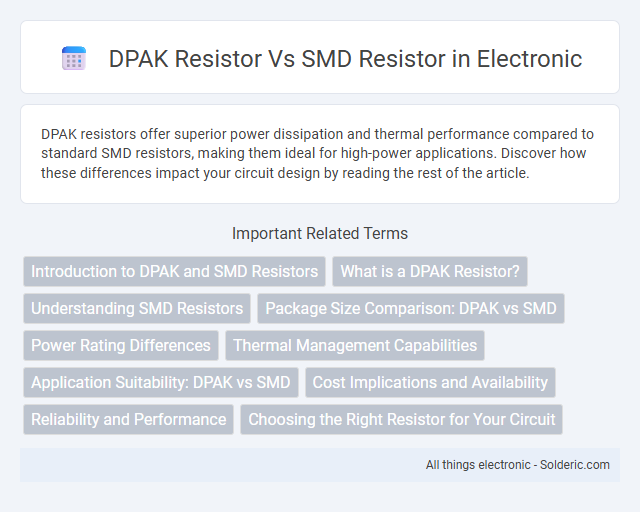DPAK resistors offer superior power dissipation and thermal performance compared to standard SMD resistors, making them ideal for high-power applications. Discover how these differences impact your circuit design by reading the rest of the article.
Comparison Table
| Feature | DPAK Resistor | SMD Resistor |
|---|---|---|
| Package Type | Discrete Packaged (DPAK) | Surface Mount Device (SMD) |
| Mounting | Surface mount with larger footprint | Compact surface mount |
| Power Rating | Higher wattage, typically up to 3W | Lower wattage, common ranges 0.05W to 0.5W |
| Size | Larger, suitable for high-power applications | Smaller, ideal for compact circuit designs |
| Thermal Management | Better heat dissipation due to package design | Limited heat dissipation |
| Typical Applications | Power electronics, automotive circuits | Consumer electronics, compact PCBs |
| Cost | Generally higher due to size and power capability | Lower cost, mass-produced for standard use |
| Examples | LM317 DPAK resistor array | 0805, 0603 SMD resistors |
Introduction to DPAK and SMD Resistors
DPAK resistors are power resistors designed for surface-mount applications, featuring a sturdy package with a metal tab for enhanced heat dissipation, making them ideal for high-power circuits. SMD resistors encompass a broad category of surface-mount resistors that come in various sizes and power ratings, optimized for low-profile, automated assembly on printed circuit boards (PCBs). Your choice between DPAK and standard SMD resistors depends on the power handling requirements and mechanical stability needed in your electronic design.
What is a DPAK Resistor?
A DPAK resistor is a surface-mount device (SMD) designed with a distinctive D-shaped package for efficient heat dissipation and compact board layout. Unlike traditional SMD resistors, which typically come in flat rectangular packages, DPAK resistors integrate the resistor with a metal heat sink tab, enabling higher power ratings and improved thermal management. Your choice of a DPAK resistor is ideal for applications requiring robust power handling and reliable surface mounting.
Understanding SMD Resistors
SMD resistors, including DPAK resistors, are surface-mount components designed for compact and automated PCB assembly, offering high reliability and space efficiency. Unlike traditional through-hole resistors, SMD resistors such as the DPAK package provide improved thermal management and electrical performance, crucial for modern electronics. Your choice of SMD resistor impacts device miniaturization and circuit stability, making it essential to understand specifications like power rating and tolerance.
Package Size Comparison: DPAK vs SMD
DPAK resistors typically feature larger package sizes, providing better heat dissipation and higher power ratings compared to standard SMD resistors, which are designed for compact, space-saving applications. The physical footprint of DPAK is significantly bigger, often around 6.7 mm x 9.8 mm, whereas SMD resistors, such as the popular 0805 or 0603 sizes, are much smaller, typically under 2.0 mm x 1.25 mm. This size difference directly impacts their suitability for applications needing either high thermal performance or minimal PCB space.
Power Rating Differences
DPAK resistors typically offer higher power ratings, often ranging from 1 to 5 watts, compared to standard SMD resistors which usually max out at around 0.25 to 0.5 watts. Their larger surface area and robust construction allow DPAK resistors to dissipate heat more effectively, making them suitable for high-power applications. Understanding these power rating differences helps you select the right resistor type to ensure reliability and performance in your electronic design.
Thermal Management Capabilities
DPAK resistors offer superior thermal management capabilities compared to typical SMD resistors due to their larger metal heat sink area, allowing efficient heat dissipation. The DPAK package's thermal pad enhances conduction to the PCB, reducing junction temperature and improving reliability under high power conditions. In contrast, standard SMD resistors have limited surface area and thermal mass, restricting their heat dissipation capacity and suitability for high-power applications.
Application Suitability: DPAK vs SMD
DPAK resistors excel in power dissipation and thermal management, making them ideal for high-current applications such as voltage regulation and power supplies. SMD resistors, characterized by their compact size and surface-mount technology, suit high-density circuit boards where space-saving is critical, typically in signal processing or low-power devices. Your choice depends on balancing power handling requirements and PCB layout constraints, with DPAK favoring robust power applications and SMD optimized for compact, lightweight designs.
Cost Implications and Availability
DPAK resistors generally incur higher production costs due to their larger package size and thermal management features, affecting overall pricing compared to standard SMD resistors that benefit from mass production efficiencies. SMD resistors are widely available with extensive supplier networks and come in various standard sizes, making them cost-effective and readily accessible for most applications. The availability of DPAK resistors is more limited and typically targets specialized applications requiring higher power dissipation, influencing their pricing and procurement timelines.
Reliability and Performance
DPAK resistors offer enhanced thermal dissipation and mechanical stability compared to standard SMD resistors, resulting in higher reliability under high-power conditions. Their robust packaging reduces the risk of damage from mechanical stress and improves heat conduction, which boosts performance in demanding applications. Choosing a DPAK resistor can extend your circuit's lifespan and maintain consistent resistance values during thermal cycling.
Choosing the Right Resistor for Your Circuit
Selecting the right resistor for your circuit involves comparing DPAK resistors and SMD resistors in terms of size, power dissipation, and thermal management. DPAK resistors offer higher power ratings and better heat dissipation, making them ideal for high-power applications, while SMD resistors excel in compact designs with reliable performance in low to moderate power circuits. Your choice depends on the circuit's power requirements and available board space, ensuring optimal efficiency and durability.
DPAK resistor vs SMD resistor Infographic

 solderic.com
solderic.com